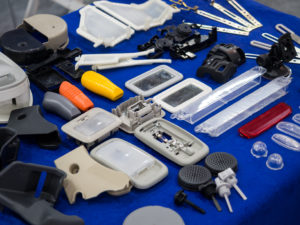Intro
Urethane casting is one of the best options for medium-volume production runs. It creates production-quality plastic parts in a fraction of the time that traditional machining would take. The finished parts are high-quality, highly repeatable, and low-cost.
If you want to learn more about urethane casting, you came to the right place. In this guide, we’ll give a quick definition, then we’ll tell you about the step-by-step process that urethane casting fabricators use to make your parts.
What Is Urethane Casting?
The term “urethane casting” can be broken into two parts: urethane, and casting.
Urethane is a material that acts and looks like a production-quality polymer. In other words, it’s a hard-working plastic.
Casting is the process of pouring a liquid into a mold, letting it cool and harden, then removing a final product.
When you combine these terms, you can understand what urethane casting is. It’s a fabrication process that pours liquid urethane into a mold, then it cools and creates a hardened urethane part. This process can be repeated in the same mold, and each time it will create a nearly identical part.
The actual process can be done with hundreds of different types of plastics. All of which have unique material properties, so you can pick how strong, flexible, and resistant the final part is.
It’s worth specifying that the final product is made out of whatever liquid material is poured into the mold.
The Step-By-Step Process That Urethane Casting Uses

To understand how it works, we broke the process down into seven steps. Most urethane manufacturers will use these exact steps, in the same sequence.
Step #1: Make the Model
It all starts with a 3D model. A designer will create the final product in their 3D CAD software. If you want your final part to be a case for an amplifier, then the designer will create the amp case in perfect detail, at a 1:1 scale.
Without this model, a modern machine shop won’t be able to guarantee that your final product will have the right tolerances, functionality, and features that you’re looking for.
The model is also useful in the future when the mold wears out and the machine shop needs to make a new one. They can use the same 3D model to create a new mold.
Step #2: Fabricate the Silicone Mold
The machine shop will take your 3D model, then put together a silicone mold. There are two options to make the mold:
The first, and more common option is to first 3D print your 3D model. The 3D print will be highly accurate and a physical model of your final part. The fabricator will then encase the 3D-printed part in silicone and create a negative into the silicone.
The second, less common option is to create a negative of your 3D model in 3D CAD. From there, the machinist can create a silicone mold of the newly created 3D model.
In either case, the result of this step is a physical silicone mold that has a negative image of your final product.
We typically use silicone because it’s inexpensive, can hold a shape well, and it’s durable enough to get plenty of use before it degrades.
Step #3: Prep the Urethane
The mold is one half of the equation, and the other half is the urethane. At this point, the urethane casting expert will combine two liquid phases of urethane. During this step, they’ll create the right material properties that you want your part to have.
It’s important to note that the urethane is liquid in this stage.
Step #4: Fill the Mold
The liquid urethane is then poured into the silicone mold from step #2. The entire cavity needs to be filled.
The problem with hand-pouring urethane is that the little nooks and crannies of the silicone mold might not be filled. There could also be air bubbles and pockets trapped within the part. Without dealing with this, you’ll get a final part that isn’t complete, is missing features, or has performance issues.
How is that issue solved? It happens during step #5.
Step #5: Apply Heat and/or Pressure
To solve the problem, the mold expert will typically apply heat, pressure, or a combination of the two. For really simple parts, this step might be skipped altogether.
By heating up the mold, the urethane will flow better and will move past air pockets. By applying vacuum, the air pockets are forcibly removed. Either process will result in a cavity that gets filled completely.
Step #6: Peel Apart the Mold
Now the urethane casting expert will wait for a while. During this time, the liquid urethane in the mold is cooling down, hardening, and solidifying into the finished part.
Once enough time has passed, the manufacturer will peel apart the mold, and remove your product from the cavity.
Just like that, you have a single, finished unit.
Step #7: Repeat the Process
The fabricator will keep repeating steps 3 to 6 until they have the right quantity of units for your order. Typically Rapid Axis can pull 25-30 parts from Soft Tooling before the tool expires and a new one needs to be made.
In the meantime, they’ll keep filling it with urethane, letting it cool, and removing the production-quality part.
Conclusion
As you can see, this fabrication technique has a lot to appreciate. Our customers come from all different industries and rely on urethane casting for countless different applications. If you want to learn how your operation can benefit from this manufacturing method, reach out to our team.
We have full urethane casting capabilities in-house, and we can meet your production demands. Get a free quote today to get started.
